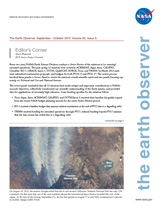The Earth Observer has a new look! Visit the NEW Earth Observer website.
The Earth Observer: Sep - Oct 2013
In This Issue
Click title below to view page
- Editor’s Corner Front Cover
- Feature Articles
- The SAGE Legacy’s Next Chapter: SAGE III on the International Space Station4
- NASA Reaches Conservation Biology Community9
- NASA Satellite Data Used to Study the Impact of Oil Palm Expansion Across Indonesian Borneo12
- Meeting/Workshop Summaries
- Land, Atmosphere Near-Real-Time Capability for EOS (LANCE) User Working Group Meeting Summary17
- ESIP Federation Meeting Highlights Data Practices21
- Summary of the 43rd Advanced Spaceborne Thermal Emission and Reflection Radiometer (ASTER) Science Team Meeting24
- Announcements
- Data Release: Version 007 HIRDLS Atmospheric Products8
- Data Release: Version 4 SeaWiFS Deep Blue23
- Come Explore NASA Science at the 2013 Fall AGU Meeting28
- In The News
- Around the World in Four Days: NASA Tracks Chelyabinsk Meteor Plume27
- After a Fire, Before a Flood: NASA’s Landsat Directs Restoration to At-Risk Areas29
- Search On for Climate Clues Across Southern U.S. Skies31
- Regular Features
- NASA Earth Science in the News 32
- NASA Science Mission Directorate – Science Education and Public Outreach Update 34
- Science Calendars 35
Editor’s Corner
Steve Platnick
EOS Senior Project Scientist
Every two years NASA’s Earth Science Division conducts a Senior Review of the missions in (or entering) extended operations. This past spring 13 missions were reviewed: ACRIMSAT, Aqua, Aura, CALIPSO, CloudSat, EO-1, GRACE, Jason-1, OSTM, QuikSCAT, SORCE, Terra, and TRMM. In March 2013 each team submitted continuation proposals, and budgets for both FY14-15 and FY16-17. The review process involved three panels: a Science Panel to review the mission’s overall scientific merit and two panels focusing separately on Technical and Cost and National Interests.
Read more...

